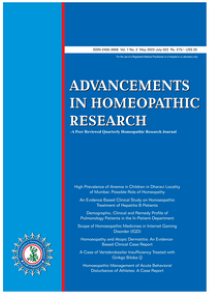Heavy Metals in Homoeopathic Mother Tinctures – Is it a Cause for Concern?
DOI:
https://doi.org/10.48165/ahr.2023.8.1.1Keywords:
Herbs, heavy metals, mother tincture, toxicityAbstract
Introduction: The presence of heavy metals in higher quantity is a cause for concern in herbal medicines. Around 60-70% of homoeopathic medicines are manufactured using herbs. Herbs account for even more than 90% of the frequently used mother tinctures. There is a possibility of heavy metals transfer from herbs to the mother tincture during the manufacturing process.
Objective: This study was conducted to find out the transmission of heavy metals from herbs to mother tinctures.
Material and methods: 10 herbs have been identified based on the literature survey for the presence of heavy metals (lead, mercury, arsenic and cadmium). Samples of both herbs and the mother tinctures made from them have been studied for the presence of heavy metals in mg/kg.
Results & discussion: 8 out of 10 herbs were found to contain heavy metals. However, none of the homoeopathic mother tinctures prepared from these herbs has any trace of the presence of heavy metal. Even though mother tinctures are diluted 10 times and they may contain 1/10th of heavy metals present in the herbs, we could not find even 1/10th of the heavy metal in the mother tincture. This could be due to their insoluble nature in the solvents used. Perhaps all the heavy metals have been retained into the herbal residue.
Conclusion: Heavy metals present in the studied herbs do not transport during the manufacturing of homoeopathic mother tinctures. Thus, these homoeopathic mother tinctures may be considered safe with respect to heavy metals.
References
Rasool A, Bhat KM, Sheikh AA, Jan A, Hassan S. Medicinal plants: Role, distribution and future. Journal of Pharmacognosy and Phytochemistry. 2020;9(2):2111-4.
Gediya SK, Mistry RB, Patel UK, Blessy M, Jain HN. Herbal plants: used as a cosmetics. J Nat Prod Plant Resour. 2011;1(1):24-32.
Ernst E. Toxic heavy metals and undeclared drugs in Asian herbal medicines. Trends in pharmacological sciences. 2002 Mar 1;23(3):136-9.
Lakherwal D. Adsorption of heavy metals: a review. International journal of environmental research and development. 2014 Nov;4(1):41-8.
Demirbas A. Heavy metal adsorption onto agro based waste materials: a review. Journal of hazardous materials. 2008 Sep 15;157(2-3):220-9.
Li Q, Liu H, Alattar M, Jiang S, Han J, Ma Y, Jiang C. The preferential accumulation of heavy metals in different tissues following frequent respiratory exposure to PM2. 5 in rats. Scientific Reports. 2015 Nov 19;5(1):16936.
Wilkinson JM, Hill J, Phillips CJ. The accumulation of potentially-toxic metals by grazing ruminants. Proceedings of the Nutrition Society. 2003 May;62(2):267-77.
European Pharmacopoeia Commission. Determination of aflatoxin B1 in herbal drugs. European Pharmacopoeia. 2016;2(18):289.
Gasser U, Klier B, Kühn AV, Steinhoff B. Current Findings on the Heavy Metal Content in Herbal Drugs. Pharmeur Sci Notes 2009 (1): 37-50.
Luo L, Wang B, Jiang J, Fitzgerald M, Huang Q, Yu Z, Li H, Zhang J, Wei J, Yang C, Zhang H, Dong L and Chen S (2021) Heavy Metal Contaminations in Herbal Medicines: Determination, Comprehensive Risk Assessments, and Solutions. Front. Pharmacol. 11:595335. doi: 10.3389/fphar.2020.595335.
Järup L. Hazards of heavy metal contamination. British medical bulletin. 2003 Dec 1;68(1):167-82. 12 Parker GH, Gillie CE, Miller JV, Badger DE,
Kreider ML. Human health risk assessment of arsenic, cadmium, lead, and mercury ingestion from baby foods. Toxicology reports. 2022 Jan 1;9:238- 49.
Mehrandish R, Rahimian A, Shahriary A. Heavy metals detoxification: A review of herbal compounds for chelation therapy in heavy metals toxicity. J Herbmed Pharmacol. 2019;8(2):69-77. doi: 10.15171/jhp.2019.12.
World Health Organization. Safety issues in the preparation of homeopathic medicines. World Health Organization; 2009.
Herbal drugs, general monograph 1433. European Pharmacopeia, 9th edition. Strasbourg, France: Council of Europe; 2016 (vol 1).
Albert H, Klier B, Knödler M, Steinhoff B. Findings on the heavy metal content in herbal drugs and essential oils-an update. Pharmeuropa bio & Scientific Notes. 2018 Jan 1;2018:62-111.
Elemental impurities – Limits, general chapter <232>. First Supplement to USP 40, NF 35. Rockville, USA: United States Pharmacopeial Convention, Inc; 2016: 8065-8069.
Indian Pharmacopoeia Commission. Indian Pharmacopoeia, 2022
European Pharmacopeia. Herbal drugs for homoeopathic preparations, monograph 2045. Ph. Eur. Suppl. 7.5. Strasbourg, France: Council of Europe; 2012.
Busch J, Werner W, Huwer A. Study of the risk of heavy metal transfer to homoeopathic mother tinctures. Pharmeuropa Bio & Scientific Notes. 2012 Apr 1;2012:55-71.
Homoeopathic Pharmacopoeia of India, Volume 1- 10, Ministry of Ayush, Government of India.
Schedule M1, Good Manufacturing Practices and Requirements Of Premises, Plant and Equipment for Homoeopathic Medicines, Drugs and Cosmetics Act and Rules, first published in 2008 and amended in 2017 by Government of India.
Cheng Z, Lee L, Dayan S, Grinshtein M, Shaw R. Speciation of heavy metals in garden soils: evidences from selective and sequential chemical leaching. Journal of Soils and Sediments. 2011 Jun;11:628-38.
Ghori Z, Iftikhar H, Bhatti MF, Sharma I, Kazi AG, Ahmad P. Phytoextraction: the use of plants to remove heavy metals from soil. InPlant metal interaction 2016 Jan 1 (pp. 385-409). Elsevier.
Singh R, Gautam N, Mishra A, Gupta R. Heavy metals and living systems: An overview. Indian J Pharmacol. 2011 May;43(3):246-53.




